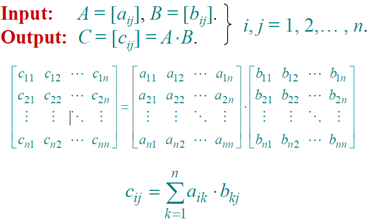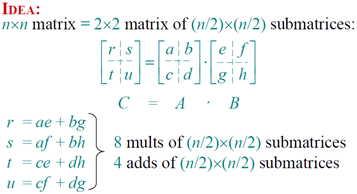The divide-and-conquer design paradigm
1. Divide the problem (instance)
into subproblems.
2. Conquer the subproblems by
solving them recursively.
3. Combine subproblem solutions.
merge sort
1. Divide: Trivial.
2. Conquer: Recursively sort 2 subarrays.
3. Combine: Linear-time merge.

Master theorem (reprise)
T(n) = aT(n/b) + f (n)
CASE 1: f (n) = O(nlogba –ε)
⇒ T(n) = Θ(nlogba) .
CASE 2: f (n) =Θ(nlogba lgkn)
⇒ T(n) = Θ(nlogba lgk+1n) .
CASE 3: f (n) = Ω(nlogba +ε) and a f (n/b) ≤ c f (n)
⇒ T(n) = Θ( f (n)) .
Merge sort: a = 2, b = 2 ⇒ nlogba = n⇒ CASE 2 (k = 0) ⇒ T(n) = Θ(n lg n) .
Binary search
1. Divide: Check middle element.
2. Conquer: Recursively search 1 subarray.
3. Combine: Trivial.
Recurrence for binary search

nlogba = nlog21 = n0 = 1⇒ CASE 2 (k = 0)⇒ T(n) = Θ(lg n) .
Powering a number
Problem: Compute, where n ∈ N.
Naive algorithm: Θ(n).
Divide-and-conquer algorithm:

T(n) = T(n/2) + Θ(1) . T(n) = Θ(lg n) .
Fibonacci numbers
Recursive definition:

0 1 1 2 3 5 8 13 21 34 ….
Naive recursive algorithm: Ω()
(exponential time), where φ =( )/2 is the golden ratio.
Computing Fibonacci numbers
Naive recursive squaring:
Fn = /
rounded to the nearest integer.
• Recursive squaring: Θ(lg n) time.
• This method is unreliable, since floating-point
arithmetic is prone to round-off errors.
Bottom-up
• Compute F0, F1, F2, …, Fn in order, forming
each number by summing the two previous.
• Running time: Θ(n).
Recursive squaring
Theorem:

Algorithm: Recursive squaring.Time = Θ(lg n) .
Proof of theorem. (Induction on n.)


Matrix multiplication

Standard algorithm
for i ← 1 to n
do for j ← 1 to n
do cij ← 0
for k ← 1 to n
do cij ← cij + aik⋅ bkj
Running time = Θ(n3)
Divide-and-conquer algorithm

Analysis of D&C algorithm

nlogba = nlog28 = n3 ⇒ CASE 1 ⇒ T(n) = Θ(n3).
No better than the ordinary algorithm.
Strassen's idea
• Multiply 2×2 matrices with only 7 recursive mults.
P1 = a ⋅ ( f – h)
P2 = (a + b) ⋅ h
P3 = (c + d) ⋅ e
P4 = d ⋅ (g – e)
P5 = (a + d) ⋅ (e + h)
P6 = (b – d) ⋅ (g + h)
P7 = (a – c) ⋅ (e + f )
r = P5 + P4 – P2 + P6
s = P1 + P2
t = P3 + P4
u = P5 + P1 – P3 – P7
7 mults, 18 adds/subs.
Note: No reliance on
commutativity of mult!
Strassen's algorithm
1. Divide: Partition A and B into
(n/2)×(n/2) submatrices. Form terms
to be multiplied using + and – .
2. Conquer: Perform 7 multiplications of
(n/2)×(n/2) submatrices recursively.
3. Combine: Form C using + and – on
(n/2)×(n/2) submatrices.
T(n) = 7 T(n/2) + Θ(n2)
Analysis of Strassen
T(n) = 7 T(n/2) + Θ(n2)
nlogba = nlog27 ≈ n2.81 ⇒ CASE 1 ⇒ T(n) = Θ(nlg 7).
The number 2.81 may not seem much smaller than
3, but because the difference is in the exponent, the
impact on running time is significant. In fact,
Strassen's algorithm beats the ordinary algorithm
on today's machines for n ≥ 30 or so.on today's machines for n ≥ 30 or so.
on today's machines for n ≥ 30 or so.
VLSI layout
Problem: Embed a complete binary tree

H(n) = H(n/2) + Θ(1) W(n) = 2 W(n/2) + Θ(1)
= Θ(lg n)= Θ(n)
with n leaves in a grid using minimal area.
Area = Θ(n lg n)






















 5万+
5万+











 被折叠的 条评论
为什么被折叠?
被折叠的 条评论
为什么被折叠?








